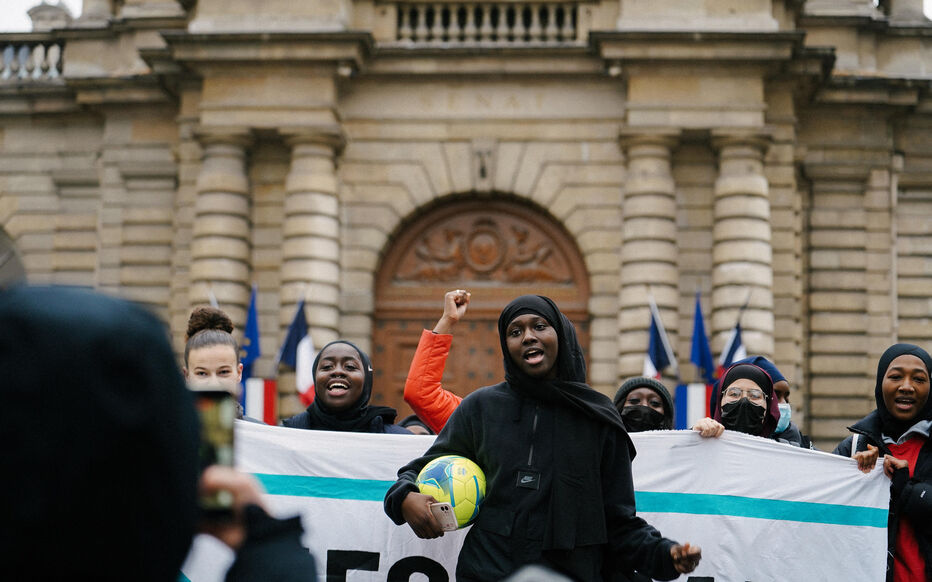The protracted German debate on Muslim teachers’ right to wear the hijab when working in the public sector has received its newest episode. The State Labour Court (Landesarbeitsgericht) of Berlin and Brandenburg decided in favour of a Muslim teacher who had sued the state of Berlin for barring her from exercising her profession because of her hijab.
Landmark decision by the Constitutional Court
In German public schools, pupils are free to wear the Muslim headcovering; yet the situation with respect to teachers is more complex. This is partly linked to the country’s federalised geography: educational matters are generally not governed from Berlin but handled by the capitals of the country’s 16 federal states, leading to often strongly differing educational practices.
As Euro-Islam reported, Germany’s top Constitutional Court had overturned North-Rhine Westphalia’s blanket ban on teachers wearing the Muslim headscarf in 2015; yet the practices of state governments have been slow to adapt. Moreover, the precise implications of the Court’s verdict itself have remained unclear.
While the judges rejected a generalised ban of the hijab, it did not unconditionally allow its wearing, either. In fact, based on the verdict, school authorities retain the right to prohibit individual teachers from wearing the hijab if they demonstrate that the teacher’s clothing constitutes “a sufficiently concrete threat or disruption of school peace”.1
Current court cases
Perhaps also because of this considerable degree of equivocation in the Court’s judgements, a number of states have not changed their discriminatory practices. Instead, state governments have preferred to wait until Muslim women take to the courts, attempting to enforce their right to wear a hijab.
Subsequently, lower-instance courts have issued a number of verdicts that appear favourable to Muslim women’s demands. Yet upon further inspection, the judges have often dodged the real issues at stake.
In 2016, a Munich Administrative Court, for instance, ostentatiously ruled in favour of a junior lawyer whom the State of Bavaria had banned from wearing a headscarf while working at court. Yet in its reasoning, the court based itself on purely formal grounds, thus refraining from commenting on the overall legality of prohibiting women from wearing the hijab while fulfilling public functions.
The situation in Berlin
In Berlin, the local government did not amend its legal provisions after the Constitutional Court’s landmark verdict on the hijab. It seems that the state authorities deemed themselves immune from legal challenges because Berlin’s “neutrality law” (Neutralitätsgesetz) does not explicitly discriminate against the hijab: in fact, it prohibits the wearing of any and all religious symbols in public service.2
In the present case, the court of first instance had dismissed the teacher’s lawsuit. In its verdict, it based itself on the non-discriminatory nature of Berlin’s neutrality law, arguing that the educational board had the right to refuse an applicant with a hijab.3
This judgement has now been overturned in the second instance by the State Labour Court. Now, the judge argued that the State of Berlin did in fact discriminate against the prospective teacher by refusing to employ her because of her headscarf. Consequently, the State was condemned to pay the woman close to 9,000 Euros in salaries.4
Caveats persist
However, like in the case of the Munich junior lawyer, the court’s verdict comes with a caveat: the State Labour Court did not object to the neutrality law itself. For the judge, the neutrality law itself is fully constitutional.
Instead, the court objected to the fact that state educational authorities had not sufficiently justified their decision to deny employment to the plaintiff: the state had failed to demonstrate that the “school peace” would be threatened or disrupted by the presence of a headscarf-wearing woman.5
Walking a tightrope
This showcases how the court sought to bridge the divide between Berlin’s neutrality law on the one hand and the verdict of the Constitutional Court on the other hand – an exercise that resembles walking on a tightrope.
The neutrality law itself incorporates in its Article 3 a provision that allows educational authorities to exempt individual teachers from the requirement of absolute religious neutrality, provided that this measure does not endanger the “ideological-religious neutrality” of the school in question and does not threaten “school peace”.6
This might appear to allow a reconciliation of the neutrality law with the Constitutional Court’s verdict. Yet it is noteworthy that the Berlin law flips on its head the default position that underlies constitutionally acceptable restrictions on the wearing of the hijab.
The Constitutional Court argues that it is per se legal for teachers to wear the hijab, unless it be proven that the headscarf upsets the orderly working of the school. Conversely, the State of Berlin starts from the position that it is per se illegal for teachers to wear the hijab, unless it be shown that the religious symbol in question does not undermine school peace.
A question of equality
As noted above, the Constitutional Court passed its landmark ruling in 2015 in response to a case from North-Rhine Westphalia (NRW). In contrast to Berlin, the NRW state government had banned only the hijab from public schools, while continuing to allow kippah or Christian habits. Consequently, the main thrust of the Court’s verdict is directed against this unequal treatment of religious symbols.
In its verdict, the Court also briefly and somewhat hurriedly accepts as constitutional bans on religious symbols that do not discriminate between the faiths and instead prohibit all religious symbols from public institutions.7
Different versions of secularism
While this would seem to legitimise Berlin’s neutrality law, this somewhat underdeveloped aspect of the Constitutional Court’s verdict remains problematic. Most notably, the Court’s recognition of a non-discriminatory policy of neutrality departs from the German tradition of Church-State relations, anchored in Article 140 of the German Basic Law.
In contrast to the French practice of laicité on the other side of the Rhine, the post-WWII German state has defined its position vis-à-vis institutionalised religion as one of fostering and support. There are extensive cooperation agreements between state and religious bodies, for instance in various domains of social or charitable work. This cooperative framework of Church-State relations also forms the basis of the extensive confessional education offered to children in public schools.
Against this tradition of cooperation, neutrality laws introduce a more categorical separation into the German framework. It remains to be seen whether the recognition of this practice by the Constitutional Court signals the onset of a full-fledged transformation of the German system.
Political reactions
In Berlin itself, where the struggle between these two different visions of secularism will take place over the coming months and years, the reactions to the decision in the teacher’s favour have been mixed.
In its official response, the ruling coalition of Social Democratic, Green, and Left parties asserted that it would uphold the state’s neutrality law. However, the junior partners in the coalition, the Green and Left parties, criticised the law.
The city’s Justice Senator Dirk Behrendt asserted that the neutrality provision had become untenable. In his interpretation, the court’s verdict did in fact reveal the law’s irreconcilability with the Constitutional Court’s position, i.e. its unconstitutionality.8 The political debate over the place of the hijab in public institutions is thus far from over.
Sources
http://www.bundesverfassungsgericht.de/SharedDocs/Entscheidungen/DE/2015/01/rs20150127_1bvr047110.html ↩
http://gesetze.berlin.de/jportal/portal/t/iaf/page/bsbeprod.psml?pid=Dokumentanzeige&showdoccase=1&js_peid=Trefferliste&fromdoctodoc=yes&doc.id=jlr-VerfArt29GBE2005pP2&doc.part=X&doc.price=0.0&doc.hl=0 ↩
http://www.zeit.de/gesellschaft/zeitgeschehen/2016-04/kopftuchverbot-berlin-urteil-arbeitsgericht-lehrerinnen ↩
http://www.zeit.de/gesellschaft/zeitgeschehen/2017-02/berlin-lehrerin-kopftuch-gericht-berufungsverfahren-entschaedigung ↩
http://www.spiegel.de/karriere/berlin-abgelehnt-wegen-kopftuch-lehrerin-bekommt-schadensersatz-a-1133806.html ↩
http://gesetze.berlin.de/jportal/portal/t/iaf/page/bsbeprod.psml?pid=Dokumentanzeige&showdoccase=1&js_peid=Trefferliste&fromdoctodoc=yes&doc.id=jlr-VerfArt29GBE2005pP2&doc.part=X&doc.price=0.0&doc.hl=0 ↩
See esp. Section III, Art. 1 c) for the Court’s positioning on that matter: http://www.bundesverfassungsgericht.de/SharedDocs/Entscheidungen/DE/2015/01/rs20150127_1bvr047110.html ↩
http://www.rbb-online.de/politik/beitrag/2017/02/berlin-kopftuchurteil-senat-neutralitaetgesetz-wird-nicht-ueberprueft.html ↩






